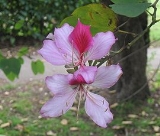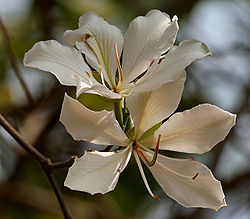
Bauhinia variegata
Encyclopedia
Bauhinia variegata is a species
of flowering plant
in the family
Fabaceae
, native to southeastern Asia
, from southern China
west to Pakistan
and India
. Common names include Orchid tree, Camel's Foot Tree and Mountain-ebony. It is called Kachnar(Hindi), (Punjabi), (Urdu) or Kanchan(Bengali) in India
.
 It is a small to medium-sized tree growing to 10–12 m tall, deciduous
It is a small to medium-sized tree growing to 10–12 m tall, deciduous
in the dry season
. The leaves
are 10–20 cm long and broad, rounded, and bilobed at the base and apex. The flower
s are conspicuous, bright pink or white, 8–12 cm diameter, with five petals. The fruit
is a pod 15–30 cm long, containing several seed
s.
This is a very popular ornamental tree in subtropical and tropical climates, grown for its scented flowers. In the Neotropics, it can be used to attract hummingbird
s - such as Sapphire-spangled Emerald
(Amazilia lactea), Glittering-bellied Emerald
(Chlorostilbon lucidus), or White-throated Hummingbird
(Leucochloris albicollis) - into gardens and parks. On the other hand, in some areas it has become naturalised
and invasive
.
bacterial strains.
while in urdu it is called کچنار
Species
In biology, a species is one of the basic units of biological classification and a taxonomic rank. A species is often defined as a group of organisms capable of interbreeding and producing fertile offspring. While in many cases this definition is adequate, more precise or differing measures are...
of flowering plant
Flowering plant
The flowering plants , also known as Angiospermae or Magnoliophyta, are the most diverse group of land plants. Angiosperms are seed-producing plants like the gymnosperms and can be distinguished from the gymnosperms by a series of synapomorphies...
in the family
Family (biology)
In biological classification, family is* a taxonomic rank. Other well-known ranks are life, domain, kingdom, phylum, class, order, genus, and species, with family fitting between order and genus. As for the other well-known ranks, there is the option of an immediately lower rank, indicated by the...
Fabaceae
Fabaceae
The Fabaceae or Leguminosae, commonly known as the legume, pea, or bean family, is a large and economically important family of flowering plants. The group is the third largest land plant family, behind only the Orchidaceae and Asteraceae, with 730 genera and over 19,400 species...
, native to southeastern Asia
Asia
Asia is the world's largest and most populous continent, located primarily in the eastern and northern hemispheres. It covers 8.7% of the Earth's total surface area and with approximately 3.879 billion people, it hosts 60% of the world's current human population...
, from southern China
China
Chinese civilization may refer to:* China for more general discussion of the country.* Chinese culture* Greater China, the transnational community of ethnic Chinese.* History of China* Sinosphere, the area historically affected by Chinese culture...
west to Pakistan
Pakistan
Pakistan , officially the Islamic Republic of Pakistan is a sovereign state in South Asia. It has a coastline along the Arabian Sea and the Gulf of Oman in the south and is bordered by Afghanistan and Iran in the west, India in the east and China in the far northeast. In the north, Tajikistan...
and India
India
India , officially the Republic of India , is a country in South Asia. It is the seventh-largest country by geographical area, the second-most populous country with over 1.2 billion people, and the most populous democracy in the world...
. Common names include Orchid tree, Camel's Foot Tree and Mountain-ebony. It is called Kachnar(Hindi), (Punjabi), (Urdu) or Kanchan(Bengali) in India
India
India , officially the Republic of India , is a country in South Asia. It is the seventh-largest country by geographical area, the second-most populous country with over 1.2 billion people, and the most populous democracy in the world...
.

Deciduous
Deciduous means "falling off at maturity" or "tending to fall off", and is typically used in reference to trees or shrubs that lose their leaves seasonally, and to the shedding of other plant structures such as petals after flowering or fruit when ripe...
in the dry season
Dry season
The dry season is a term commonly used when describing the weather in the tropics. The weather in the tropics is dominated by the tropical rain belt, which oscillates from the northern to the southern tropics over the course of the year...
. The leaves
Leaf
A leaf is an organ of a vascular plant, as defined in botanical terms, and in particular in plant morphology. Foliage is a mass noun that refers to leaves as a feature of plants....
are 10–20 cm long and broad, rounded, and bilobed at the base and apex. The flower
Flower
A flower, sometimes known as a bloom or blossom, is the reproductive structure found in flowering plants . The biological function of a flower is to effect reproduction, usually by providing a mechanism for the union of sperm with eggs...
s are conspicuous, bright pink or white, 8–12 cm diameter, with five petals. The fruit
Fruit
In broad terms, a fruit is a structure of a plant that contains its seeds.The term has different meanings dependent on context. In non-technical usage, such as food preparation, fruit normally means the fleshy seed-associated structures of certain plants that are sweet and edible in the raw state,...
is a pod 15–30 cm long, containing several seed
Seed
A seed is a small embryonic plant enclosed in a covering called the seed coat, usually with some stored food. It is the product of the ripened ovule of gymnosperm and angiosperm plants which occurs after fertilization and some growth within the mother plant...
s.
This is a very popular ornamental tree in subtropical and tropical climates, grown for its scented flowers. In the Neotropics, it can be used to attract hummingbird
Hummingbird
Hummingbirds are birds that comprise the family Trochilidae. They are among the smallest of birds, most species measuring in the 7.5–13 cm range. Indeed, the smallest extant bird species is a hummingbird, the 5-cm Bee Hummingbird. They can hover in mid-air by rapidly flapping their wings...
s - such as Sapphire-spangled Emerald
Sapphire-spangled Emerald
The Sapphire-spangled Emerald, Amazilia lactea, is a species of hummingbird that occurs in Venezuela, Peru, Bolivia and Brazil from the Amazon south to Santa Catarina; there are uncertain records from east Ecuador. Both male and female have a bright "sapphire" blue chest and chin and green-blue...
(Amazilia lactea), Glittering-bellied Emerald
Glittering-bellied Emerald
The Glittering-bellied Emerald is a species of hummingbird in the Trochilidae family. It has widely been listed by the scientific name Chlorostilbon aureoventris, but this was shown to be mistaken by J. F. Pacheco and B. M. Whitney in 2006.It is found in north-eastern Argentina, eastern and...
(Chlorostilbon lucidus), or White-throated Hummingbird
White-throated Hummingbird
The White-throated Hummingbird is a species of hummingbird in the Trochilidae family. It is the only member of the genus Leucochloris. It is found in north-eastern Argentina, south-eastern Brazil, Paraguay, and Uruguay....
(Leucochloris albicollis) - into gardens and parks. On the other hand, in some areas it has become naturalised
Naturalisation (biology)
In biology, naturalisation is any process by which a non-native organism spreads into the wild and its reproduction is sufficient to maintain its population. Such populations are said to be naturalised....
and invasive
Invasive species
"Invasive species", or invasive exotics, is a nomenclature term and categorization phrase used for flora and fauna, and for specific restoration-preservation processes in native habitats, with several definitions....
.
Medicinal Uses
Acetone and methanol bark extracts of Bauhinia variegata has shown activity against some medically importantbacterial strains.
Footnotes
This tree is also called Kolaar کلاڑ in pakistani punjabi .while in urdu it is called کچنار

